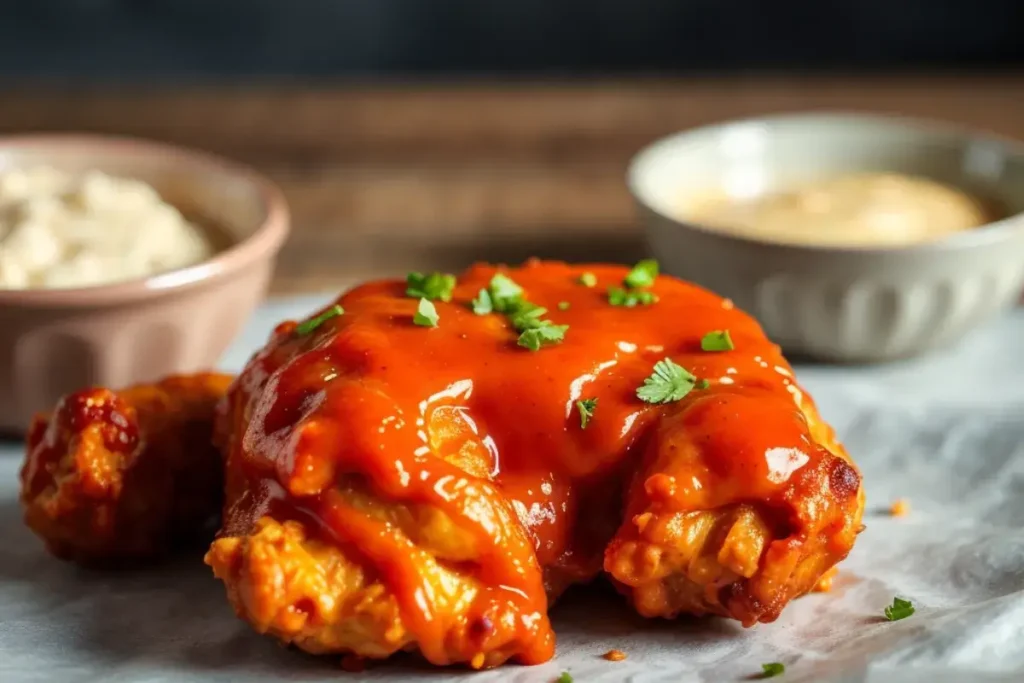Buffalo chicken is a staple in American cuisine, beloved for its bold, spicy flavor that packs a punch. Whether enjoyed as wings, tenders, or even on pizza, the heat makes buffalo chicken stand out. But have you ever wondered why buffalo chicken is so spicy? This article dives into the history, ingredients, and science behind the spiciness of buffalo chicken, offering a comprehensive understanding of what makes this dish so deliciously hot.
The Origins of This Fiery Dish
The story of buffalo chicken begins in Buffalo, New York, where the dish first emerged in the 1960s. Teressa Bellissimo, co-owner of the Anchor Bar, created buffalo wings as a late-night snack for her son and his friends. She paired the wings with a spicy sauce made from hot sauce, butter, and a few other ingredients. The dish quickly gained popularity.
Buffalo chicken’s spiciness became its signature trait, making it a favorite at sports bars and parties across the United States. Over the years, the recipe evolved, but the heat remains a central characteristic, cementing buffalo chicken as a culinary icon.
The Secret Behind Buffalo Chicken’s Heat
The fiery flavor of buffalo chicken comes from its sauce. The key ingredients are hot sauce, cayenne pepper, butter, and vinegar. The heat primarily comes from capsaicin in the cayenne peppers, which stimulates the nerve endings on your tongue and creates the sensation of spiciness.
- Hot Sauce: The base of the spiciness, hot sauce contains cayenne pepper, vinegar, and salt. The type of hot sauce used can significantly impact the spice level of the buffalo chicken, with popular brands like Frank’s RedHot leading the way.
- Cayenne Pepper: This pepper is rich in capsaicin, the compound responsible for the burning sensation. It also determines where the sauce falls on the Scoville scale, which measures the spiciness of peppers.
- Butter: Butter mellows out the sharpness of the hot sauce and adds a rich, creamy texture. However, it doesn’t significantly reduce the heat.
To understand more about how capsaicin works and why it makes food taste spicy, you can refer to a detailed discussion on capsaicin and its effects on the body.
The Role of Capsaicin in Spiciness
Capsaicin, the active component in chili peppers, gives buffalo chicken its signature kick. When you eat something spicy, capsaicin binds to receptors in your mouth that detect temperature and pain. This triggers a burning sensation, even though no actual heat is involved. Your brain interprets this as spiciness, and your body responds by releasing endorphins, creating a mild euphoria—another reason why some people love spicy foods.
Capsaicin is measured on the Scoville scale, which ranks the heat of peppers based on their capsaicin content. For example, cayenne peppers, commonly used in buffalo sauce, range between 30,000 and 50,000 Scoville heat units (SHU). This level is quite spicy but not as intense as other chili peppers like habaneros or ghost peppers. For more information on the Scoville scale, you can read a comprehensive guide here.
How Spicy Can Buffalo Chicken Get?

Buffalo chicken is versatile, offering variations to suit different spice tolerances. Restaurants often offer buffalo chicken in varying degrees of spiciness:
- Mild: A gentler version of the classic, often with more butter or additional ingredients like honey to tone down the heat.
- Medium: The standard spice level, with a balanced heat that most people can enjoy.
- Hot: For those who love a fiery kick, hot buffalo chicken delivers a more intense burn.
- Extra Hot: Reserved for the bravest spice lovers, extra hot versions might include hotter peppers like habaneros or additional hot sauce.
These variations allow everyone to enjoy buffalo chicken, regardless of their tolerance for spicy foods.
The addition of ingredients like garlic, vinegar, or other seasonings can also tweak the flavor profile while maintaining or adjusting the heat.
Why Do Some People Find Buffalo Chicken Spicier Than Others?
Not everyone experiences spiciness the same way. Several factors influence how spicy buffalo chicken tastes to an individual:
- Genetics: Some people are genetically more sensitive to capsaicin, which means they feel the burn more intensely.
- Exposure: If you regularly eat spicy food, you might develop a higher tolerance over time, making buffalo chicken seem less spicy.
- Personal Preference: Some people simply enjoy the sensation of spiciness, while others find it overwhelming.
The way we perceive heat is highly individual, which is why buffalo chicken can taste very different from one person to another. While one person might savor the slow-building burn of medium wings, another might find them too spicy to handle.
The Science Behind Cooling the Heat: Dipping Sauces and Sides

To enjoy buffalo chicken without being overwhelmed by the heat, pair it with cooling sides. Traditionally, buffalo wings are served with blue cheese or ranch dressing, both of which contain dairy. Dairy products reduce the burn from capsaicin because they contain casein, a protein that binds to capsaicin molecules and helps wash them away from the receptors in your mouth.
- Blue Cheese Dressing: Its strong, tangy flavor complements the spiciness of buffalo chicken while providing a cooling effect.
- Ranch Dressing: A milder option, ranch is creamy and soothing, making it a popular choice for those who prefer less heat.
In addition to dipping sauces, sides like celery sticks, carrot sticks, and even a cold beer can help take the edge off the spiciness. These sides not only cool your palate but also offer a refreshing contrast to the hot, flavorful chicken. If you’re enjoying buffalo chicken in a wrap, here’s a guide on What Goes With Chicken Wraps to elevate your meal.
Cultural Significance of Buffalo Chicken
Buffalo chicken isn’t just a dish; it’s a significant part of American culture. It started in Buffalo, New York, but has since become a culinary phenomenon. Buffalo chicken wings are a must-have at sports events, parties, and gatherings across the country. The dish’s strong association with football games, especially the Super Bowl, makes it a go-to snack for sports enthusiasts.
Over time, the buffalo flavor has expanded beyond wings. Today, you can find it in buffalo chicken pizza, sandwiches, salads, and dips. For a delicious twist, try this Buffalo Chicken Wrap Recipe. This versatility helps buffalo chicken maintain its popularity while also adapting to different tastes and dietary preferences.
Health Considerations: Is Buffalo Chicken Good for You?
Buffalo chicken, while delicious, comes with health considerations. The dish is often high in calories, fat, and sodium, especially when deep-fried and coated in a rich, buttery sauce. However, it also offers some surprising health benefits due to capsaicin.
- Capsaicin’s Health Benefits: Capsaicin, the compound that makes buffalo chicken spicy, is linked to several health benefits. It can boost metabolism, relieve pain, and improve blood circulation.
- Nutritional Content: Traditional buffalo chicken wings are high in protein, essential for muscle repair and growth. However, the high fat content from frying and butter can increase cholesterol levels if consumed in large quantities.
- Potential Downsides: Overeating spicy foods, including buffalo chicken, may cause gastrointestinal issues like acid reflux or stomach ulcers. The high sodium content in buffalo sauce can also pose risks for those with high blood pressure or heart disease.
For a healthier version, consider alternatives. Baking the chicken instead of frying, using a low-fat sauce, or trying buffalo cauliflower can reduce the calorie count while keeping the spicy flavor.
The Evolution of Buffalo Chicken Recipes
Since the 1960s, the buffalo chicken recipe has seen many transformations. The classic combination of chicken wings, hot sauce, and butter remains popular, but modern twists have added new dimensions to this dish.
- Vegetarian and Vegan Versions: With the rise of plant-based diets, buffalo chicken has been reimagined with ingredients like cauliflower, tofu, and seitan. These alternatives mimic the texture of chicken while soaking up the spicy buffalo sauce, making them popular among vegetarians and vegans.
- Fusion Cuisine: Buffalo chicken has also inspired various fusion dishes. You’ll find buffalo chicken sushi rolls, tacos, and even mac and cheese. These creative adaptations blend the spicy buffalo flavor with different culinary traditions.
- Homemade Buffalo Chicken: As more people cook at home, homemade buffalo chicken recipes have become popular. These recipes allow customization, enabling cooks to adjust the spice level, choose healthier ingredients, and create dishes for specific dietary needs.
The Popularity of Buffalo Chicken in Different Cuisines
Buffalo chicken’s popularity isn’t limited to the United States. The dish has gained international acclaim and has been adapted into various cuisines around the world.
- Global Variations: In Japan, buffalo chicken may be found in sushi rolls, adding a spicy kick to the delicate flavors of the fish. In Mexico, buffalo chicken tacos blend the heat of buffalo sauce with traditional Mexican ingredients like avocado and salsa.
- Fusion Creations: Buffalo chicken has inspired chefs to create new dishes that blend flavors from different culinary traditions. For example, buffalo chicken ramen combines the heat of buffalo sauce with the rich broth of Japanese ramen, creating a unique and flavorful dish.
These global adaptations show buffalo chicken’s versatility and its ability to blend with diverse flavors and cooking styles.
Common Myths About Buffalo Chicken Spiciness
Buffalo chicken’s popularity has led to several myths about its spiciness. Let’s clear up some of the most common ones:
- Myth 1: More Butter Makes It Less Spicy: Butter can mellow the sharpness of hot sauce, but it doesn’t eliminate the spiciness. The capsaicin in the hot sauce still delivers a significant kick, even with extra butter.
- Myth 2: All Buffalo Chicken is Equally Spicy: This is far from true. Buffalo chicken comes in various spice levels, ranging from mild to extra hot. The heat level varies based on the recipe, the type of hot sauce used, and personal preference.
- Myth 3: Eating Spicy Food Always Causes Stomach Issues: While spicy foods can cause discomfort for some, not everyone experiences problems. Many people regularly enjoy spicy food without any adverse effects. However, it’s important to listen to your body and eat spicy foods in moderation.
Tips for Controlling Spiciness When Making Buffalo Chicken

Making buffalo chicken at home allows you to control the spice level to suit your taste. Here are some tips for adjusting the heat:
- Choose the Right Hot Sauce: Different hot sauces have varying levels of spiciness. If you prefer a milder dish, opt for a hot sauce with lower Scoville heat units (SHU).
- Add More Butter or Dairy: Adding more butter or a dairy product like cream or yogurt can tone down the heat without compromising flavor.
- Use Milder Peppers: If cayenne pepper is too spicy, consider using milder peppers like paprika or bell peppers to create a flavorful but less intense buffalo sauce.
- Dilute the Sauce: Mixing buffalo sauce with honey, ketchup, or a bit of broth can reduce the spiciness while adding depth to the flavor.
- Cook the Chicken Differently: Baking or grilling the chicken instead of frying can also affect the overall spiciness. These methods might produce a slightly milder flavor since they don’t trap the sauce as much as frying does.
FAQs: Common Questions About Buffalo Chicken Spiciness
Why is buffalo chicken called buffalo chicken? Buffalo chicken gets its name from its place of origin, Buffalo, New York. The dish was created at the Anchor Bar, where it was first served as spicy chicken wings.
Can you make buffalo chicken without it being spicy? Yes, you can make a milder version of buffalo chicken by using less hot sauce or substituting it with a sauce that has little to no heat. Adding more butter or dairy ingredients can also reduce the spiciness.
How can you reduce the heat in buffalo chicken? To reduce the heat, use a milder hot sauce, add more butter, or mix in ingredients like honey or cream. Serving the chicken with cooling sides like blue cheese or ranch dressing also helps balance the spiciness.
Is buffalo chicken always deep-fried? While traditional buffalo chicken wings are deep-fried, many people opt to bake, grill, or even air-fry their chicken. These methods offer a healthier alternative while still delivering the classic buffalo flavor.
Conclusion
Buffalo chicken’s spiciness is what makes it a beloved dish across the United States and beyond. Whether you’re a fan of intense heat or prefer a milder version, there’s no denying the appeal of this flavorful dish. From its humble beginnings in Buffalo, New York, to its global adaptations, buffalo chicken continues to captivate taste buds with its perfect blend of heat and flavor.
By understanding the history, science, and cultural significance of buffalo chicken, you can appreciate why this dish holds such a special place in American cuisine. So next time you enjoy buffalo chicken, whether at a game, party, or dinner table, you’ll know exactly what makes it so deliciously spicy.

